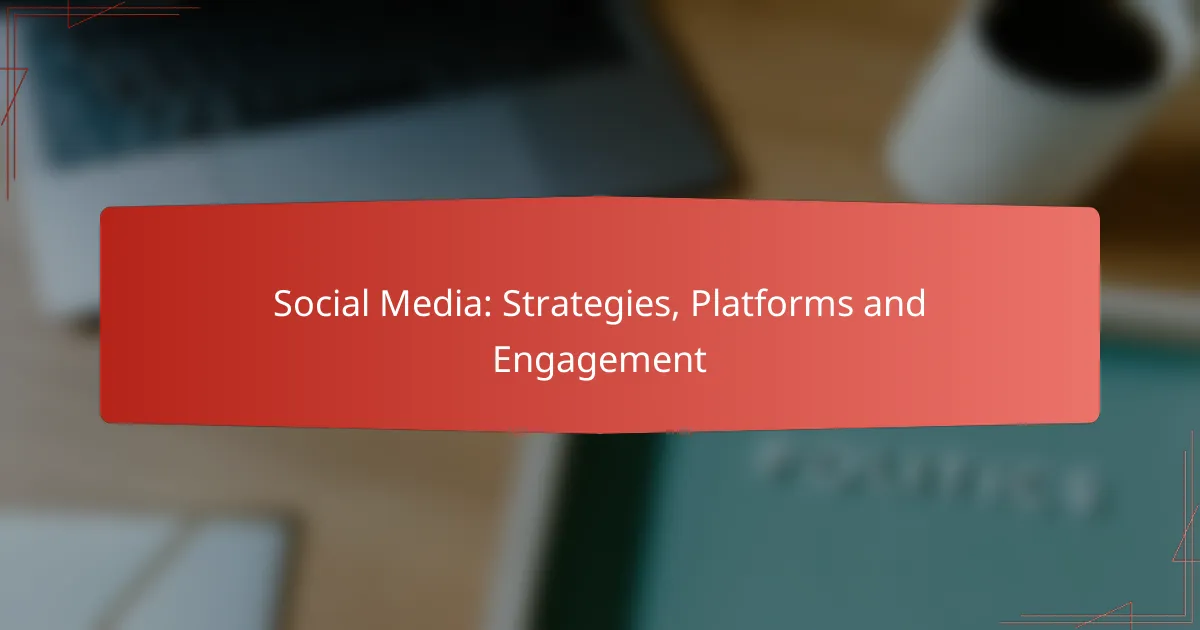In today’s digital landscape, effective social media strategies are essential for businesses aiming to enhance their online presence and engage with customers. By creating compelling content, forming strategic partnerships, and utilizing targeted advertising, companies can foster loyalty and drive growth. Choosing the right platform is crucial, as each offers distinct advantages tailored to different audiences and marketing objectives. Additionally, measuring engagement through metrics like likes, shares, and comments provides valuable insights into the success of these strategies.

What are effective social media strategies for businesses?
Effective social media strategies for businesses focus on creating engaging content, building partnerships, and utilizing targeted advertising. By leveraging these approaches, companies can enhance their online presence and foster customer loyalty.
Content marketing strategy
A strong content marketing strategy is essential for attracting and retaining customers on social media. Businesses should create valuable, relevant content that resonates with their target audience, such as blog posts, videos, and infographics.
Consider using a content calendar to plan and schedule posts consistently. Aim for a mix of promotional and informative content, with a general guideline of 80% value-driven posts and 20% promotional material.
Influencer partnerships
Influencer partnerships can significantly boost brand visibility and credibility. Collaborating with influencers who align with your brand values allows you to reach their followers and tap into new audiences.
When selecting influencers, consider their engagement rates and audience demographics. Micro-influencers, with smaller but highly engaged followings, can often provide a better return on investment compared to larger influencers.
Engagement tactics
Engagement tactics are crucial for building a loyal community around your brand. Encourage interaction through polls, questions, and user-generated content, which can foster a sense of belonging among followers.
Responding promptly to comments and messages is vital. Aim to reply within a few hours to maintain a positive relationship with your audience and show that you value their input.
Paid advertising campaigns
Paid advertising campaigns can enhance your reach and target specific demographics effectively. Platforms like Facebook and Instagram offer robust targeting options based on user behavior, interests, and location.
Set a clear budget for your campaigns and monitor performance regularly. A/B testing different ad formats and messaging can help identify what resonates best with your audience, allowing for optimized spending and improved results.

Which social media platforms are best for advertising?
The best social media platforms for advertising depend on your target audience and marketing goals. Facebook, Instagram, LinkedIn, and TikTok each offer unique advantages for different demographics and business objectives.
Facebook for targeted ads
Facebook is a powerful platform for targeted advertising due to its extensive user data and sophisticated ad targeting options. Advertisers can segment audiences based on demographics, interests, and behaviors, making it easier to reach specific groups.
Consider using Facebook Ads Manager to create campaigns that align with your marketing goals. You can choose from various ad formats, including image, video, and carousel ads, to engage users effectively.
Instagram for visual engagement
Instagram excels in visual storytelling, making it ideal for brands that rely on striking imagery or video content. With a younger audience, it’s particularly effective for lifestyle, fashion, and beauty brands.
Utilize Instagram Stories and Reels to create engaging, ephemeral content that captures attention. Collaborating with influencers can also enhance your reach and credibility on the platform.
LinkedIn for B2B marketing
LinkedIn is the go-to platform for B2B marketing, allowing businesses to connect with professionals and decision-makers. It’s particularly effective for lead generation and promoting industry-related content.
Focus on creating informative content, such as whitepapers and case studies, to establish authority. Sponsored content and InMail ads can help you reach targeted professionals directly in their inboxes.
TikTok for younger audiences
TikTok is rapidly gaining popularity among younger audiences, making it a valuable platform for brands targeting Gen Z and millennials. Its short-form video format encourages creativity and engagement.
To succeed on TikTok, create authentic, entertaining content that resonates with users. Consider leveraging trends and challenges to increase visibility, and collaborate with popular creators to broaden your reach.

How to measure social media engagement?
Measuring social media engagement involves tracking various metrics that indicate how users interact with your content. Key indicators include likes, shares, comments, and overall audience growth, which help assess the effectiveness of your social media strategies.
Engagement rate metrics
Engagement rate metrics quantify how actively your audience interacts with your posts. Common calculations include the total engagement (likes, comments, shares) divided by the total number of followers, often expressed as a percentage. A typical engagement rate can range from 1% to 5%, depending on the platform and industry.
To improve your engagement rate, focus on creating high-quality, relevant content that resonates with your audience. Regularly analyze which posts perform best and consider adjusting your strategy based on these insights.
Follower growth analysis
Follower growth analysis tracks how your audience size changes over time, providing insights into the effectiveness of your outreach efforts. Monitoring this metric helps identify trends, such as spikes in growth after specific campaigns or content types.
To effectively analyze follower growth, compare your follower count over different periods, such as weekly or monthly. A steady increase is a positive sign, while sudden drops may indicate issues that need addressing, such as content relevance or engagement quality.
Conversion tracking
Conversion tracking measures how many social media interactions lead to desired actions, such as website visits, sign-ups, or purchases. This metric is crucial for understanding the return on investment (ROI) of your social media efforts.
Utilize tools like Google Analytics or platform-specific insights to set up conversion tracking. Define clear goals, such as increasing newsletter subscriptions by a certain percentage, and regularly assess your performance against these targets.
Sentiment analysis tools
Sentiment analysis tools evaluate the emotional tone of user interactions with your brand on social media. These tools can help you understand public perception and identify potential issues before they escalate.
Popular sentiment analysis tools include Brandwatch, Hootsuite Insights, and Sprout Social. Regularly review sentiment data to gauge audience reactions to your campaigns and adjust your messaging accordingly to maintain a positive brand image.

What are the prerequisites for a successful social media campaign?
A successful social media campaign requires clear objectives, thorough audience research, and a well-structured content calendar. These elements ensure that your messaging resonates with your target audience and achieves your desired outcomes.
Clear objectives and goals
Establishing clear objectives and goals is essential for guiding your social media campaign. These should be specific, measurable, achievable, relevant, and time-bound (SMART). For example, aiming to increase brand awareness by 20% over six months provides a clear target.
Consider what you want to achieve, whether it’s boosting engagement, driving website traffic, or generating leads. Align your goals with your overall marketing strategy to ensure consistency across all channels.
Target audience research
Understanding your target audience is crucial for tailoring your content effectively. Conduct demographic and psychographic research to identify their interests, preferences, and online behaviors. Utilize tools like surveys, social media analytics, and competitor analysis to gather insights.
Segment your audience based on characteristics such as age, location, and interests. This allows for more personalized messaging, which can significantly enhance engagement rates and conversion potential.
Content calendar development
A content calendar helps organize and plan your social media posts in advance. It should outline what content will be published, when, and on which platforms. This ensures a consistent posting schedule and allows for timely responses to trends or events.
Include a mix of content types, such as promotional posts, educational articles, and user-generated content. Aim for a balanced approach that keeps your audience engaged without overwhelming them with promotional material. Regularly review and adjust your calendar based on performance metrics to optimize your strategy.

How to choose the right social media platform?
Selecting the right social media platform involves understanding your target audience, the type of content you plan to share, and your advertising budget. Each platform has unique characteristics that cater to different demographics and content formats, making it essential to align your strategy with your goals.
Audience demographics
Understanding audience demographics is crucial when choosing a social media platform. Each platform attracts different age groups, interests, and behaviors. For instance, Instagram and TikTok are popular among younger users, while Facebook has a broader age range, including older adults.
To effectively reach your target audience, research the demographic data of each platform. Consider factors such as gender, location, and interests to ensure your content resonates with the users you want to engage.
Content type suitability
The type of content you intend to create should guide your platform choice. Visual content, such as images and videos, performs well on platforms like Instagram and YouTube, while text-based content may be better suited for Twitter or LinkedIn.
Evaluate the strengths of each platform regarding content formats. For example, if your strategy includes live video, Facebook and Instagram offer features that support this type of engagement effectively.
Advertising budget considerations
Your advertising budget plays a significant role in selecting a social media platform. Some platforms, like Facebook, offer a range of ad formats and targeting options, making it suitable for various budget levels. Others, like LinkedIn, may require a higher investment for effective reach.
Determine your budget and assess the cost-per-click (CPC) or cost-per-impression (CPM) rates on different platforms. This will help you identify where your advertising dollars will be most effective and ensure you maximize your return on investment.

What are emerging trends in social media marketing?
Emerging trends in social media marketing include the rise of short-form video content, increased focus on authenticity, and the integration of augmented reality (AR) features. Marketers are adapting to these trends to enhance engagement and reach their target audiences more effectively.
Short-form video content
Short-form video content, popularized by platforms like TikTok and Instagram Reels, is becoming essential for social media marketing. These bite-sized videos capture attention quickly and are easily shareable, making them ideal for brand storytelling and product promotion.
To leverage short-form videos, brands should focus on creating engaging, visually appealing content that conveys their message within a few seconds. Consider using catchy music, trending challenges, or user-generated content to enhance relatability and engagement.
Authenticity and transparency
Consumers increasingly value authenticity and transparency from brands on social media. This trend emphasizes genuine interactions, behind-the-scenes content, and real customer testimonials, which help build trust and foster community.
To embrace this trend, brands should prioritize honest communication and showcase their values. Sharing user experiences and responding to feedback openly can strengthen relationships with followers and enhance brand loyalty.
Augmented reality (AR) features
Augmented reality features are gaining traction in social media marketing, allowing users to interact with products in immersive ways. Platforms like Snapchat and Instagram offer AR filters and effects that enhance user engagement and create memorable experiences.
Brands can utilize AR to enable virtual try-ons, interactive ads, or engaging games. This not only boosts user engagement but also provides a unique way for customers to experience products before making a purchase, potentially increasing conversion rates.



